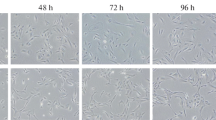Abstract
Monolayer cultures of the pigmented epithelial (PE) cells derived from two regions of the pars plicata of bovine eyes were established and grown up to the third passage. After this passage, the cultures became senescent. During the first three passages, the PE cells lost their pigment granules but developed a distinct cellular polarity by forming junctional complexes at their apical cell portions and depositing basement membrane like material on their basal side. The junctional complexes were shown to be impermeable for horseradish peroxidase, suggesting that they contained tight junctions. Histochemically, the monolayer cells stained for carbonic anhydrase (CA) and Na+/K+-ATPase, enzymes involved in active fluid secretion. Staining for CA and Na+/K+-ATPase as well as for acid phosphatase and immunostaining for vimentin and actin of the cultured PE cells were comparable with that of PE cells in vivo. Therefore, PE monolayer cultures are considered to be a suitable model for experimental studies in vitro.
Similar content being viewed by others
References
Chayen J, Frost GTB, Dodds RA, Bitensky L, Pitchfork J, Baylis PH, Barrnett RJ (1981) The use of a hidden metal-capture reagent for the measurement of Na+/K+-ATPase activity: a new concept in cytochemistry. Histochemistry 71:533–541
Coca-Prados M, Kondo K (1985) Separation of bovine pigmented ciliary epithelial cells by density gradient and further characterization in culture. Exp Eye Res 40:731–739
Deurs B van, Tonnessen TI, Petersen OW, Sandvig K, Olsnes S (1986) Routing of internalized ricin and ricin conjugates to the golgi complex. J Cell Biol 102:37–47
Eichhorn M, Flügel C (1988) Histochemical demonstration of carbonic anhydrase and Na+/K+-ATPase in the pecten oculi of the fowl. Exp Eye Res 47:147–153
Eichhorn M, Flügel C, Lütjen-Drecoll E (1990) Regional differences in the bovine ciliary body. An ultrastructural and histochemical study. Fortschr Ophthalmol 87:241–246
Eichhorn M, Flügel C, Lütjen-Drecoll E (1991) Regional differences in the distribution of intermediate filaments in the human and bovine ciliary epithelium. Graefe's Arch Clin Exp Ophthalmol 230:385–390
Flügel C, Lütjen-Drecoll E (1988) Presence and distribution of Na+/K+-ATPase in the ciliary epithelium of the rabbit. Histochemistry 88:613–621
Hansson HPJ (1967) Histochemical demonstration of carbonic anhydrase activity. Histochemie 11:112–128
Helbig H, Korbmacher C, Wiederholt M (1987) K+-conductance and electrogenic Na+-K+-transport of cultured bovine pigmented ciliary epithelium. J Membr Biol 99:973–986
Helbig H, Korbmacher C, Kühner D, Berweck S, Wiederholt M (1988) Characterization of Cl−/HCO3 − exchange in cultured bovine pigmented ciliary epithelium. Exp Eye Res 47:515–523
Ito S, Karnovsky MJ (1968) Formaldehyde-glutaraldehyde fixatives containing trinitro compounds. J Cell Biol 39:168a–169a
Lütjen-Drecoll E (1982) Functional morphology of the ciliary epithelium. In: Lütjen-Drecoll E (Ed) Basic aspects of glaucoma research. Schattauer, Stuttgart
Lütjen-Drecoll E, Lönnerholm G (1981) Carbonic anhydrase distribution in the rabbit eye by light and electron microscopy. Invest Ophthalmol Vis Sci 21:782–797
Lütjen-Drecoll E, Lönnerholm G, Eichhorn M (1983) Carbonic anhydrase distribution in the human and monkey eye by light and electron microscopy. Graefe's Arch Clin Exp Ophthalmol 220:285–291
Lütjen-Drecoll E, Kaufman P, Eichhorn M (1986) Long term timolol and epinephrin in monkeys. I. Functional morphology of the ciliary processes. Trans Ophthalmol Soc UK 105:180–195
Owaribe K, Kartenbeck J, Rungger-Brändle E, Franke WW (1988) Cytoskeletons of retinal pigment epithelial cells: interspecies differences of expression pattern indicate independence of cell function from specific complement of cytoskeletal proteins. Cell Tissue Res 254:301–315
Raviola G (1974) Effects of paracentesis on the blood-aqueous barrier: an electron microscope study onMacaca mulatta using horseradish-peroxidase as a tracer. Invest Opthhalmol Vis Sci 13:828–848
Ridderstråle Y (1976) Intracellular localization of carbonic anhydrase in the frog nephron. Acta Physiol Scand 98:465–469
Robinson JM, Karnovsky MJ (1983) Ultrastructural localization of several phosphatases with cerium. J Histochem Cytochem 31:1197–1208
Smith RS (1973) Ultrastructural studies of the blood aqueous barrier. 2. The barrier to horseradish peroxidase in primates. Am J Ophthalmol 76:937–947
Smith RS, Rudt LA (1975) Ocular vascular and epithelial barriers to microperoxidase. Invest Ophthalmol Vis Sci 14:556–560
Spoerri PE, Dresp W, Heyder E (1980) A simple embedding technique for monolayer neuronal cultures grown in plastic flasks. Acta Anat 107:221–223
Strauss O, Wiederholt M (1991) Transepithelial resistance of ciliary epithelial cells in culture: functional modification by protamin and extracellular calcium. Comp Biochem Physiol 100A:987–993
Vegge T (1971) An epithelial blood-aqueous barrier to horseradish-peroxidase in the processes of the newt monkey (Cercopithecus aethiops). Z Zellforsch Mikr Anat 114:309–320
Wiederholt M, Flügel C, Lütjen-Drecoll E, Zadunaisky JA (1989) Mechanically stripped pigmented and non-pigmented epithelium of the shark ciliary body: morphology and transepithelial electrical properties. Exp Eye Res 49:1031–1043
Author information
Authors and Affiliations
Rights and permissions
About this article
Cite this article
Eichhorn, M., Bermbach, G., Dermietzel, R. et al. Characterization of bovine ciliary pigmented epithelial cells in monolayer culture: An ultrastructural, enzyme histochemical and immunohistochemical study. Graefe's Arch Clin Exp Ophthalmol 231, 21–28 (1993). https://doi.org/10.1007/BF01681696
Received:
Accepted:
Issue Date:
DOI: https://doi.org/10.1007/BF01681696




